13th October
I’m starting with ‘The Big Plunge’, close to home and in the wider world. Then to cobwebs, which kick off our story of craft & textiles projects (AKA Craftivism), past and present. Finally some thoughts about achieving improved river quality.


Autumn has definitely arrived, with mounds of crunchy sycamore leaves under my feet each morning, as I run through the heavy mists. And along with the rhythm of my feet, my brain is kind of pulsing too, dreaming up and evaluating the many activities due to be delivered in Half Term. Today (Friday) my Zen-like state is abruptly broken, when a squirrel decides to take a highly dramatic plunge from above my head and lands almost on top of me, with a thud. To my amazement it picks itself up and scampers away without damage, which has brought me back to my laptop for instant research. Do squirrels have ‘suspension’ or springs in their feet, or what?
Well, I found a few sources, worth a glance, both American. https://www.mcgill.ca/oss/article/did-you-know/squirrels-can-survive-fall-any-height-least-hypothetically from which I borrow a few lines:-
Squirrels are not very heavy—a grey squirrel only weighs about 0.5 kg—meaning that the force acting on a falling squirrel just isn’t that big.
Force = mass x gravity/acceleration = 0.5 kg x 9.81 m/s2 = 4.9 N(ewtons)
On top of being small, squirrels are fluffy and intuitively spread their bodies out when falling. This allows them to experience as much wind resistance as possible, slowing down their rate of descent.
For these 2 reasons, the terminal velocity (fastest speed while falling) of squirrels is slow enough that they will, at least in principle, never fall so hard that they hurt themselves.
And https://guloinnature.com/do-squirrels-land-like-superheroes/ where you can see, an analysis of ‘style’ is involved!
Adorably, their method of landing is much less elegant and stylish than a superhero landing. I call it “the splat”. When in a controlled fall, squirrels will spread their limbs out wide to increase air resistance and hit the ground like a bushy-tailed pancake. This helps spread the force of the impact over a greater area to prevent injury.
Nevertheless, I must say this ‘Bushy Tailed Pancake’ made a resounding plop, which I now take as analogy to represent a much more serious descent – e.g. today’s state of ‘World Peace’.
It is beyond shocking to describe the huge change, in the last 7 days, brought about by a terrorist act, murdering over a thousand men, women and even babies, in cold blood. I have just been debating, with my neighbour Verna over a coffee, ‘should a Climate Hope blog even mention this? Is it relevant at all?’ We soon agreed, yes it is. There are significant climate implications, whether making warheads, transporting them and of course the emissions at explosion and the need eventually to remediate war zones and rebuild.
A further element is the distraction of national leaders, as described here – https://www.eenews.net/articles/war-in-the-middle-east-jeopardizes-climate-talks/
Sustained conflict could make it more difficult to navigate climate negotiations, scheduled next month in the United Arab Emirates on the Arabian Peninsula, by raising tensions between nations with fragile alliances and triggering a race to secure energy resources over reducing carbon emissions. At a time when reducing fossil fuels should be a centrepiece of the discussions,“Instability provides challenges to any attempt at trying to build a difficult bridge to consensus.”
Every inch of this plunge towards war is also a plunge for Climate Change. Horrific ☹



Back to Half Term preparations
Top of the list this past week have been craft and textiles challenges, working out how to make birds, bees & butterflies for our explorations of pollination and seed dispersal. First, I was helped along by Louise (resident artist) and Jacqui (member of U3A craft group), then on Saturday came 3 generations of one family – Mary, Shelley and Lerryn.
Jacqui was quick off the mark, making 22 lovely felt apples for the apple tree fruit branches. Big thank you, Jacqui! Louise began her input with the skinnier apple blossom branches, wiring paper flowers onto the dried branches of last season’s New Zealand flax plant (or Phormium). That done, she began to create little puppets, from old socks and pipe cleaners, and fixed them onto pre-prepared Morris Dancing poles. Who would have guessed we could take recycling to this level of inventiveness?!



Cornwall W.I. – Climate and Crafts
As I departed Verna’s house I was given a lovely little booklet called ‘Green Tips, Coping with Climate Change’, as a donation to the Library here at Meadow Barns. Verna told me how her membership of the local W.I. opens up numerous avenues for learning, enjoyable socialising and sharing support (practical and emotional). These ‘Green Tips’ are a great example, set out in a no-nonsense, very basic and practical manner.



I fear the writing on those images is none too clear. The front cover mentions W.I. Climate Ambassadors, about which I was able to discover a certain amount online:-
When a WI member registers as a Climate Ambassador, they are provided with a range of helpful resources including a climate communication guide produced in conjunction with the climate communication organisation ‘Climate Outreach’ (a team of social scientists and communications specialists), a monthly climate newsletter, and access to training webinars and events.
The Scheme provides a voluntary opportunity for members who are passionate about climate and who want to make a difference in their communities. Being a Climate Ambassador is what you make it. There are no formal time commitments, and the scheme is designed to fit around your existing schedule. The aim is to provide further support for WI members who would like to take local community action on environmental matters.
Some examples of the great community projects that Climate Ambassadors have undertaken are:-
- Working with pupils from a local primary school and a local care home to install an ‘eco-brick’ bench at the school
- Building a relationship with their local MP
- Organising ‘Show the Love’ celebrations in their community
- Running a campaign to encourage members to plant trees in their local communities
- Delivering waste recycling talks to WI branches
- Holding their own community ‘Fixing Fast Fashion’ event to take action on the WI’s ‘End Plastic Soup’ campaign
- Delivering climate communication talks to WI branches in their Federation
- Creating bee-friendly havens in their gardens and local communities for our ‘SOS for Honeybees‘ campaign
My initial response is that these topics are a bit heavy on gimmick titles, though they clearly start with the right aims and have been able to make a difference. But there is nothing as good as words from the horse’s mouth, so I was delighted to get a chance to interview one of those Climate Ambassadors, Mary Lindsey from Truro area, on Saturday morning.
Questions I asked
Mary has been a Climate Ambassador for around 5 years. She came to Meadow Barns to encourage and assist her granddaughter, Lerryn, in making a beautiful butterfly. As she was engaged with cutting and sewing, I opened up some questions:-
- Is Cornwall outstanding? I mean, how does it figure against WI responses to the Climate Emergency across the rest of the country? Her answer was ‘I feel Cornwall stands up well, but we are lucky because this County Council declared the intention to achieve Net Zero by 2030, which has given us a strong momentum. In Truro, WI members have responded with enthusiasm and a substantial commitment of time.’
- Who decided to bring crafting skills to the issue and how important an element has this been?
Her answer ‘The idea came from a WI national Federation initiative called ‘Craftivism’, which means using Craft for Activitism. This was taken up by Truro members, who had volunteered to be Climate Ambassadors or Climate Friends and I think it is fair to say it has been a great way to build a team.’
- Did you come across the Banner/Tapestry idea from the University of Reading research and images, at ‘Partnering the Planet’ and if so what led you to it? Mary’s response in Q2 had partly answered this question. The ‘Craftivism’ initiative included studying the Reading Uni Climate Stripes and making it into a knitting pattern. Truro ladies took that pattern and used it as the basis for their own textiles version, illustrating temperatures in the UK for the past 100 years. (NB I was introduced to the following information initially by a reader, Barbara, over in Arizona. Thank you!)
No words. No numbers. No graphs. Just a series of vertical-coloured bars, showing the progressive heating of our planet in a single, striking image.
The climate stripes were created by Professor Ed Hawkins at the University of Reading in 2018. They show clearly and vividly how global average temperatures have risen over nearly two centuries. Each stripe represents the average temperature for a single year, relative to the average temperature over the period as a whole. Shades of blue indicate cooler-than-average years, while red shows years that were hotter than average. The stark band of deep red stripes on the right-hand side of the graphic show the rapid heating of our planet in recent decades.
The graphics also show how no corner of the globe is immune from the effects of global warming. Stripes images for more than 200 countries, states and cities are available to download for free from the showyourstripes.info website. People in every country can see how their home is heating and share the images, helping to start conversations about climate change.

Back to Mary
Q4 Very often needlework is something quiet and private, that happens at home. How challenging was it to plan a very large structure, which presumably involved multiple contributions of the numerous small stripes?
A We had 6 people to design and put together the background materials, and – as it was 2020 – those sessions happened outdoors, in people’s gardens! Like you, Caroline, with your Meadow Barns Covid Heroes tapestry, we were determined not to buy new, but simply to re-use old materials. We have a Caroline in our group too (Caroline Stone), who is such an amazing crafts-woman; she gave us the yellow material prepared into a suitable base shape; someone added a blanket for padding out the middle, plus an old blue sheet for the back.
Size-wise it is quite large – about 2 metres long and 1 metre deep. At the base it reads in large capital letters – WE CAN ALL MAKE A DIFFERENCE. Just above this it shows the colour-coded temperatures strip but still leaving plenty of space above, for a number of further, individually made sections in the style of a quilt. There are 7 heart-shaped pockets, each of which represents a different aspect of life in which people can make a difference. These say “Make a Difference when you travel, eat, shop, use energy, in your garden; in your home and with others.”
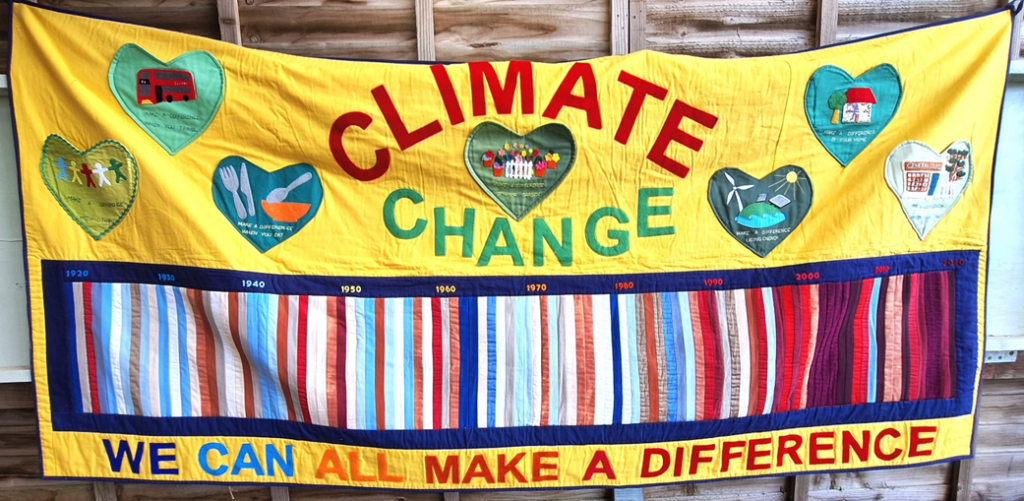
Q5 How did you decide on the Make a Difference topics?
A Initially we asked people to put their ideas on paper, and put them physically into the pockets. We looked through all these and read around the topics a lot, which led to us being able to compile 7 flyers, each with a different set of 10 top tips. Each flyer has its own pocket, so people can quickly select and help themselves to these. We have also asked people to put pledges into the pockets.
Q6 We found it quite difficult to identify suitable places for long term display and sharing of our Covid Heroes banner, with the public. How has this been for you? Where has it hung and how?
A Because we have 108 WI groups across Cornwall, with very nearly 3,000 members, it has been quite easy to achieve public sharing, though usually not for long periods of time. Opportunities have ranged from small village hall events, to the recent opening of Mid Cornwall Climate Hub in Truro, through to the very large display in our tent at the Royal Cornwall Show. Yes, it is definitely best hung. We designed it so people can reach the pockets and there are ties along the top for fixing. Like you, we also have occasionally hung it over one of those fold out tables with the pockets on the table top and the rest draped at the front.
Q7 How well has the booklet worked, supporting the Banner? A When I tell you that the initial Lottery-funded print run of 1000 soon ran out, and we have managed to pay for 600 more, which are also disappearing fast, I think that is proof that the booklet is fulfilling its purpose. But the other thing that has worked well is the individual pages, single A5 sheets. Please let your readers know, these will be available at the Lostwithiel Ceremony 4 Climate Hope on Friday 27th (here I received a big pile into my box!).
Q8 Is anything else in the pipeline? Any new plans? A It always comes from the national Federation, who recently posed us a new challenge – ‘Clean Rivers for People and Wildlife’. This is the design page and we have responded as a team in a similar way. This time, with no social distancing restrictions, unbelievably, 8 people made it all in about 4 weeks!

Q9 And what about supporting paperwork for this one? A Not yet, not in the same way. We went as a group to the SW Water AGM in Exeter and through research have realised the only way to see meaningful change on a river is when it seeks ‘Bathing Water’ designation. Maybe we should look at the possibility of Lostwithiel seeking this for the river since so many people enjoy paddling and like to swim by the bridge?’
Caroline’s last word: –
I leave that suggestion hanging in the air, with a little thought that maybe we could include this as a pledge within the Ceremony on Friday 27th. There will also be a dedicated river quality walk, on Wednesday 25th, in the company of our local Citizen Scientist, Anna, so I intend to raise the question then. To find an illustration, I visited Lost Voice, Community page on Facebook and saw not only the photo below but also some nasty looking effects on bare skin, which the GP said was likely caused by blue algal bloom. https://www.facebook.com/groups/219653688474038/search/?q=swim
Come on board
If you are available and hoping to join in some of the sessions, do please make a booking, by using the Blog Comments box/email to cjs@themeadowbarns.co.uk or Eventbrite.

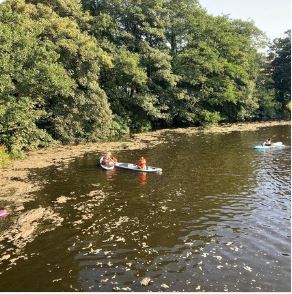

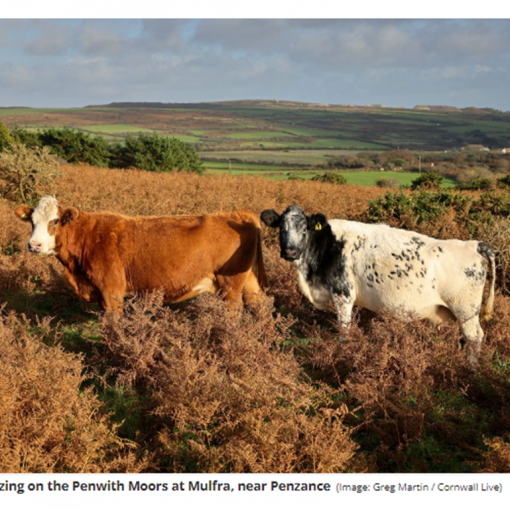

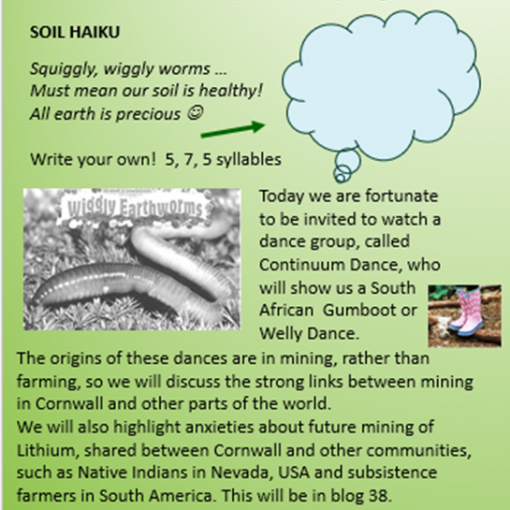
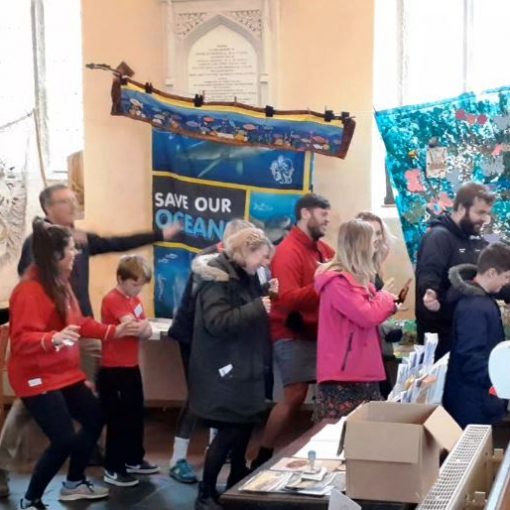
One thought on “GF Blog 23 – Week 37”
On behalf of Mary Lindsey, Caroline would like to publish this small correction – Hi Caroline
The blog looks fine except I went with members of other groups to meet with SW Water.
It wasn’t their AGM but an opportunity to confront them with our concerns.